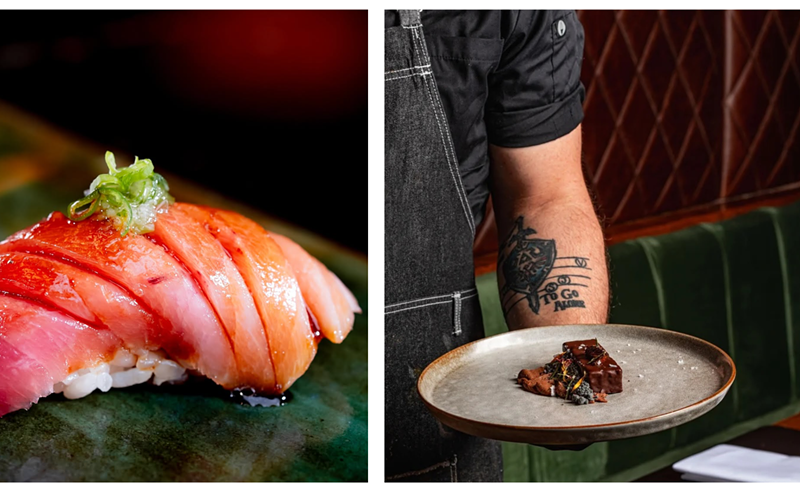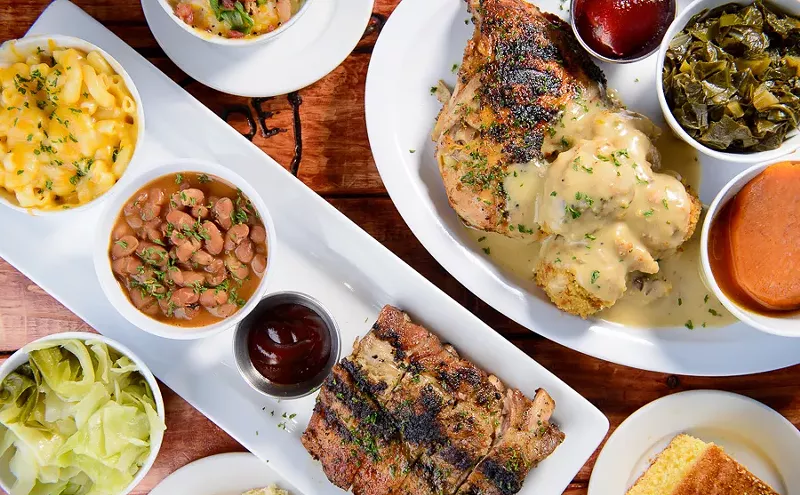What you will find is a menu that unapologetically adheres to Lebanese culinary traditions reaching back hundreds, if not thousands, of years. "Every dish has a history behind it," says chef-owner George Hedary. "It's not something that somebody just came up with out of culinary school."
Which isn't to say this cuisine isn't the byproduct of a fascinating convergence of influences. For thousands of years, the geographical position, rich soils (nurturing vines, fig trees, and an assortment of succulent fruits and vegetables), and prosperous trade of Lebanon made it a regular target of invasion by succeeding waves of foreigners: Egyptians, Assyrians, Persians, Greeks, Romans, Turks, and French, among others. Today, Lebanese cuisine represents the impact of all these disruptions from outside forces, each leaving its distinct mark.
Embracing a host of staples including lamb, burghul (crushed wheat), yogurt, olives, pine nuts, rice, chick peas, ground allspice, and grapevine leaves, Lebanese food is far more varied than that of its Middle Eastern neighbors precisely because of these foreign encroachments. The French, who had a 25-year mandate over the country following World War I, added a profoundly refining influence to this culinary melange.
George Hedary--who says he was not only born into the restaurant business, but was literally born in a restaurant--is attempting to recreate this deeply rooted cuisine in North Dallas. And he has a lot of personal history to fall back on. His parents, Antoine and Leila Hedary, operated Antoine Hedary's Lebanese Pizza in Beirut before immigrating to Fort Worth in 1976. Their original ambition was to start a Texas ranch. But high start-up costs squelched that dream, and they quickly redirected their energies into a Lebanese eatery.
The Hedary family currently operates three restaurants in the Fort Worth area--Hedary's Lebanese Restaurant, Byblos, and Celaborelle. The new venture on Belt Line near Coit is just a few blocks from a short-lived Lebanese restaurant George opened in the Promenade Shopping Center a little over eight years ago. His latest incarnation occupies a former Taco Bueno, which he says reminded him of his grandmother's house in Lebanon. Diluting a bit of the exotica inherent in this cuisine, Hedary's is lodged in a strip mall next to a Donut Palace, across from a Taco Bell/KFC combo mortared together in a sort of suburban fast-food bunker. This Tupperware-Party ambience dissipates only slightly as you enter the restaurant: Once you've taken in the intricately paned arched windows and the wood-beam ceilings, you notice that the foliage is plastic and the hewn stones in the arched doorway are actually created with painted mortar lines on shiny beige stucco. The entrance opens directly into a long, narrow dining area: a cold, echoing hollow space that should be skipped. Instead, opt for the warmer, cozier room to the right beyond the bar and exposed kitchen. This dining room is introduced by a decorative touch--a staircase seemingly rising to nowhere--borne of the same germ that inspired the fake foliage and doorway stones, but provides a more inviting atmosphere for sampling the simple, fresh flavors of this cuisine.
Pita bread--the two-layered flat wheat bread that inflates like a small pillow as it bakes--is served with virtually every dish in the Lebanese meal. Ideally, the bread is served right from the oven, hot and billowy, expelling a cloud of steam as the bread is torn open. Chewy, hearty, and a fantastic food dipper, Hedary's pita can be hit-or-miss: On two occasions it was served piping hot and fully puffed, while on two others it was collapsed and almost cold.
Perhaps the best way to enter the savory world of Lebanese cuisine is with the maza, a traditional sampling of salad dishes that varies daily at Hedary's. Here you'll discover hummus, the traditional dip made from chickpeas; batinjan mtabble, mashed eggplant with garlic sesame oil, olive oil, and lemon juice; tabbuli, burghul (or bulghur) with parsley, onion, tomatoes, lemon, and olive oil; and labni matoom, a dry yogurt exhibiting flavors similar to goat cheese. Only two selections, the dull potatoes doused in yogurt and the soggy, bland lentil salad, didn't live up to the fresh sparkle of the other selections.
Lentils, however, were given a far more exciting forum in the soup: a preparation that all too often features over-cooked lentils struggling in a stock tasting like it was made with soapy rags and spent Brillo pads. Hedary's lentil soup has a rich, savory broth with a lemon tang and tiny cubes of potato and spinach shreds; it's simply the best I've ever tasted.
Another typical Middle Eastern dish, stuffed vine leaves, is offered as an appetizer. The mehshe warak aresh--grape leaves stuffed with ground sirloin, rice, and spices, doused with lemon and accompanied by a mint- and garlic-infused yogurt dip--were densely packed, tightly wrapped, and tasty. The presentation, however, was marred by browning lemon wedges and a sliced tomato half with black rot running through the center, unappetizing blemishes that could have been alleviated with only modestly attentive prep work.
Hedary's meat dishes, however, were among the most flavorful and skillfully prepared offerings on the menu. A butcher by trade, George says his secret is knowing which cuts of meat work best with each dish. He's so meticulous that he raises his own lambs in Azle, Texas, and purchases others raised to his own specifications. His careful attention is evident in the sausages. The kafta, ground sirloin sausage with onion and parsley, was fresh and lean with an intense, but not unnerving, spark of cumin. Equally lean and flavorful was the mqaniq, lemon-splashed pork sausage with an appealing surge of coriander--an exotic, pungent herb to which the Bible makes reference--and clove.
Hedary's kibbi--the national dish of Lebanon--is a blend of ground sirloin and burghul that's stuffed with pine nuts and spices before charbroiling. Its dome shape resembles a tennis ball that's been run over by a street sweeper. A bit dense and a little heavy, it also was tasty.
Originally from Turkey and absorbed into the Lebanese culinary tradition during the Ottoman Empire's 400-year lock on the country, sujuk is a spicy hot beef sausage bathed in lemon juice. It's lean and flavorful, if a bit dry. Not as appealing as some of the other dishes was the lahm mishwi, shish kabobs with cubed ribeye, ripe tomatoes, onion quarters, and green peppers on pita bread. The ribeye was a bit overdone, dry, and not particularly flavorful, while the meat and vegetables were separated on two skewers. George says he prepares it this way because most people don't want vegetables touching their meat. I personally prefer a mingling of the roasted meat and vegetable juices.
Hedary's wine list is somewhat lackluster, with a batch of weak-kneed selections from California and France. And as seems to be the rule in far too many Dallas restaurants, the servers don't know enough about the wines to answer even the simplest questions. The list does have a thoroughly enjoyable Spanish red (Torres), however, for just $19. And for the adventurous, there's the pricey Cháteau Musar ($49.50), a Lebanese red wine that is most likely a blend of Cabernet and Cinsault. This menu really calls for a diverse selection of whites for its chicken dishes and range of salads, as well as the addition of some rich, spicy reds from the Southern Rhone in France and some concentrated California Zinfandels to stand up to the pungent spices used in the meat dishes.
The dessert menu is primarily pastries with selections such as baklava--layers of filo pastry with pistachios, sugar, and butter. A big surprise was the rice pudding, made elegant and exotic with hints of rosewater. Another pleasant surprise was the qahwi, or Lebanese coffee. The Colombian beans are roasted on the premises, and the coffee is brewed strong, almost like espresso, and infused with cardamom, a refreshingly aromatic Eastern spice.
While the service was attentive, it lacked warmth and graciousness, and we were struck by the peculiar approach of our Lebanese waiter. I don't know if his tactics were provoked by culture or just a personality quirk, but he consistently ignored my female companion--even when she posed questions to him--always redirecting and deferring to me. It reached a crescendo when he poured our wine, filling my glass first after I tasted it before moving on to hers: a serious wine-service faux pas. In Dallas--a city flush with female executives, professionals, and entrepreneurs--this particular brand of service could take the hot air out of Hedary's billowy pita faster than a hungry tear.
Glop. That's what most of the stuff that passes for Mexican food looks and tastes like. It's also what it feels like as it moils in your digestive tract powdering-up for a 21-gun salute that'll fire for about 24 hours after you eat the stuff. On its most basic level, Mexican food is a highly evolved, brutally efficient calorie-delivery and hunger suppression system fueled with gooey melted cheese, ground meat, fried tortillas, and peppers than can eject the wax from your ears with the shocking force of a Brad Pitt prenuptial glitch.
It's been said there is no real gastronomy in Mexico, no real subtlety that isn't quickly crushed by cholesterol or bulky fibrous mush catapulted out of papier-mache oblivion by a pungent pepper thrust. But these overly broad assertions ignore the rich diversity of authentic Mexican cuisine: from grilled steaks in the arid north to iguana stewed in a broth of tomatoes and chilies in Oaxaca. Coupling pork, rice, and frying--culinary elements introduced by Spanish colonialists--with corn, beans, ragouts, sauces, steaming, and braising that were common preparations among the Indians, Mexico has a cuisine that is among the most intensely colorful, hearty, and lusty in the world. Palate sensations leap from crunchy to creamy to salty to inhumanely spicy.
So it's no surprise that a few restaurateurs might try to punch holes in Tex-Mex putty-coated with the preciously swanky Southwestern glaze that often dominates Dallas' "south of the border" fare. And in the past few years, a handful of eateries boasting authentic Mexican cuisine have emerged. But while Javier's offers an upscale posture with fine but sometimes unexciting fare, Chihuahua Charlie's adds a souvenir-shop feel coupled with hit-and-miss food and service, and La Valentina's offers refinement that perpetually flirts with overdoneness, few restaurants offer an authentic Mexican experience steeped in comfortable sincerity without dramatic adulterations. Until Nuevo Leon, that is. Which is why, perhaps, there were so many Mexican families dining there during our visits.
Launched by partners David Trevino and Luis Ramirez, Nuevo Leon came to life in late 1994 in a Farmers Branch strip mall. It was modest and downscale, incorporating used furnishings and equipment. But it flourished, and the pair decided to test their Mex-mettle with a Dallas eatery a few notches above the Farmers Branch version on lower Greenville Avenue. The menus at both spots are exactly the same, except that the Dallas offshoot focuses more on presentation.
Occupying the old Cenaduria space, Nuevo Leon has a rustic, old-town-square patio feel with lots of used brick, mocha-colored walls, and watercolors depicting a variety of Mexican scenes, painted by Trevino's mother. It's a festive place with friendly, attentive servers, high ceilings, and a noise level that makes conversation with the person across from you nearly impossible without the aid of a megaphone or a sign language course. This challenge is compounded by the live music that breaks through the static nightly between 8:30 and 9 in the bar area.
But if your palate isn't dulled by decibel overload, you're in for the Mexican taste bud massage of your life. Trevino and Ramirez--who dub their eatery Mex-Mex in a corny thumbing-of-the-nose at Dallas' ubiquitous Tex-Mexiness--seek to merge the cuisines from two distinct Mexican regions. Trevino hails from Monterrey in the state of Nuevo Leon, an arid region where char-grilled steaks and tacos are culinary staples, while Ramirez comes from Guanajuato, a region rich in vegetation and famous for its explosively hot peppers. Their goal is to successfully draw on these elements with family recipes while emphasizing the variety of salsas and other sauces common in Mexico. Indeed, Nuevo Leon serves three fresh, zesty salsas with the obligatory greasy chips on paper plopped in a basket: a cold, searing, bright-green salsa made from jalapenos laced with lime and cilantro; a milder, warmer, lentil soup-colored salsa fashioned from green chilies and tomatillos; and a still milder, warmer red salsa that's rich, hearty, thick, and "saucy" rather than chunky and watery--easily among the best salsas you'll find in Dallas.
If you don't cake your gullet with too many chips--an ever-present danger in Mexican restaurants--you'll find the appetizers equally engaging. Ceviche, often a glob of fishy-smelling diced sea flesh and tomatoes terrorized by far too much lime juice and spice, was fresh, appropriately tangy, and very satisfying. And though they sound like digestive concussion bombs, the camarones rellenos--four fat pieces of lightly battered, deep-fried shrimp stuffed with white cheese and jalapeno in Chimiluigi sauce--were as attractive as they were tasty couched in a black, heated, four-legged stone pot and decorated with banana leaves.
Carne asada Chimichurri--a charred, leathery steak--didn't survive an attempted resuscitation with garlic, herbs, and hot spices, though it was redeemed slightly by the tender, chewy cheese enchilada in pasilla sauce with which it was partnered on the plate. It left me wondering if it was Mr. Trevino's homeland that was arid, or just the cattle.
No such glitches with the camarones "Luis" though, sauteed shrimp with onions, mushrooms, and poblano peppers in roast garlic oil soaked in a light, silky cream-Monterey Jack cheese sauce. Served in a skillet, the shrimp were succulent, firm, and tender and accompanied by a simple, slightly sweet fresh spinach salad plus a side of fried bananas.
Slowly cooked to "melt in your mouth" perfection is how the menu describes the cabrito al horno: guajillo-marinated young goat wrapped in banana leaves and served with a choice of carnitas (pork) or quail in mole sauce. And the kid--delicate, sweet, and tender with an equally stirring bit of quail in mole--really did melt. But show me, don't tell me. The menu also includes a variety of enchiladas and guisos (stews).
Nuevo Leon's dessert experience is a little on the odd side. Instead of bringing out a plate showcasing prepared desserts, our server presented us with a photo album containing snapshots of each dessert in various poses. We selected the crepas con cajeta--thin crepes in caramel sauce--but they were out. So we ordered the flan covered in caramelized sugar sauce and Grand Marnier. Several attempts to ignite the poor custard were unsuccessful as our server repeatedly probed it with burning matches. Perhaps a butane lighter would have done the trick. We ate it without the flaming overture, and the Grand Marnier overwhelmed it.
Service was generally pleasant and efficient if not a little rickety; our server repeatedly nudged us to get our entree order in. Owner Ramirez stopped by each table to greet diners, just like so many restaurant show-biz chefs and owners do. But with one difference: After leaving a table of guests, Ramirez would scan his dining room, and if he spotted a table that needed clearing or a server in need of assistance delivering an order, he jumped right in. This is a man who knows his restaurant is the star, not himself. And it shows.
Hedary's Lebanese Oven & Grill. 7915 Belt Line Road. (972) 233-1080. Open for Lunch Monday-Friday 11:30 a.m.-2 p.m., Saturday 11:30 a.m.-3 p.m.; open for dinner Monday-Thursday 5-10 p.m., Friday 5-11 p.m., and Saturday 3-11 p.m. Closed Sunday.
Neuvo Leon. 2013 Greenville Ave. (214) 887-8148. Open Sunday-Wednesday, 11 a.m.-10 p.m. Thursday-Saturday 11 a.m. to 2 a.m.
Hedary's:
Maza $17
Mehshe warak aresh $5.75
Kafta $8.95
Sujuk $8.95
Lahm mishwi $10.95
Rice pudding $2.50
Nuevo Leon:
Ceviche $5.95
Camarones rellenos $6.95
Camarones "Luis" $11.95
Cabrito al horno $12.95
Flan $2.25












